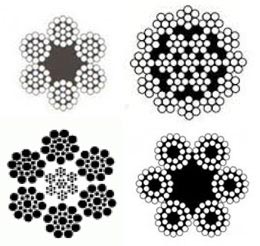 Since the early 1980’s, our expertise with wire rope has gone virtually unmatched. Our very own in-house wire rope brand, Bilco Wire and Supply, boasts over 30 years of industry experience. Our variety of wire rope is offered in several materials like stainless steel and galvanized, and serves an assortment of functions, like crane and rigging rope. Whatever your specific application is, our quality wire ropes, coupled with our faithful customer service, are sure to be the answer to your rigging and lifting needs.
Since the early 1980’s, our expertise with wire rope has gone virtually unmatched. Our very own in-house wire rope brand, Bilco Wire and Supply, boasts over 30 years of industry experience. Our variety of wire rope is offered in several materials like stainless steel and galvanized, and serves an assortment of functions, like crane and rigging rope. Whatever your specific application is, our quality wire ropes, coupled with our faithful customer service, are sure to be the answer to your rigging and lifting needs.
What is Wire Rope?
 Wire rope is a variation of a cable that is comprised of strands of metal and wire that are twisted into a helix. In most definitions, wire rope refers to cables that are at least 3/8 inches thick. Historically, wrought iron was used to create the cable, but due to the advents of modern technology, steel is now the preferred material.
Wire rope is a variation of a cable that is comprised of strands of metal and wire that are twisted into a helix. In most definitions, wire rope refers to cables that are at least 3/8 inches thick. Historically, wrought iron was used to create the cable, but due to the advents of modern technology, steel is now the preferred material.
Wire ropes were primarily used for mining applications in the 19th century. These cables were much stronger than the traditional steel chains, and now are used to hoist and lift large objects. Many structures are affixed to support towers with static wire rope.
The invention of wire rope can be attributed to a German mining engineer named Wilhelm Albert. Albert designed a wire rope with the mining industry in mind. This metallic option was much safer than the rope made of hemp and chain, and it quickly revolutionized the mining industry. Towards the beginning of the 20th century, wire ropes were used as a means of transmitting mechanical power, and were developed by John. A. Roebling, as the primary suspension force in bridges.
Steel wire rope is made from non-alloy carbon steel. Although the carbon only makes up for 0.5% of the content, the wire retains a high strength and tensile forces. There are several different types of wire rope that are all manufactured differently.
 Steel wire rope is made up of individual steel wires that are spun into a strand. The number of strands is closed over a central core, in order to make a rope. The number and size of wires is dependent upon the application that the wire is used for. Large wires provide maximum corrosion protection, while smaller wires are more flexible. Wire ropes are classified by their application and usages.
Steel wire rope is made up of individual steel wires that are spun into a strand. The number of strands is closed over a central core, in order to make a rope. The number and size of wires is dependent upon the application that the wire is used for. Large wires provide maximum corrosion protection, while smaller wires are more flexible. Wire ropes are classified by their application and usages.
The main uses of wire rope are:
Running Ropes: Running ropes are typically bent over drums and sheaves. Bending and tension stress these wires.
Spiral Ropes: Spiral ropes are tasked with handling strong tensile forces and are loaded by static and fluctuating tensile stressors. These ropes are commonly found in suspension bridges and are referred to as cables.
Track Ropes: Track ropes function as the rails for rollers and cabins. Track ropes do not take on the curvature of the rollers and can support a great amount of weight.
If you are interested in learning more about wire rope, Contact Us.